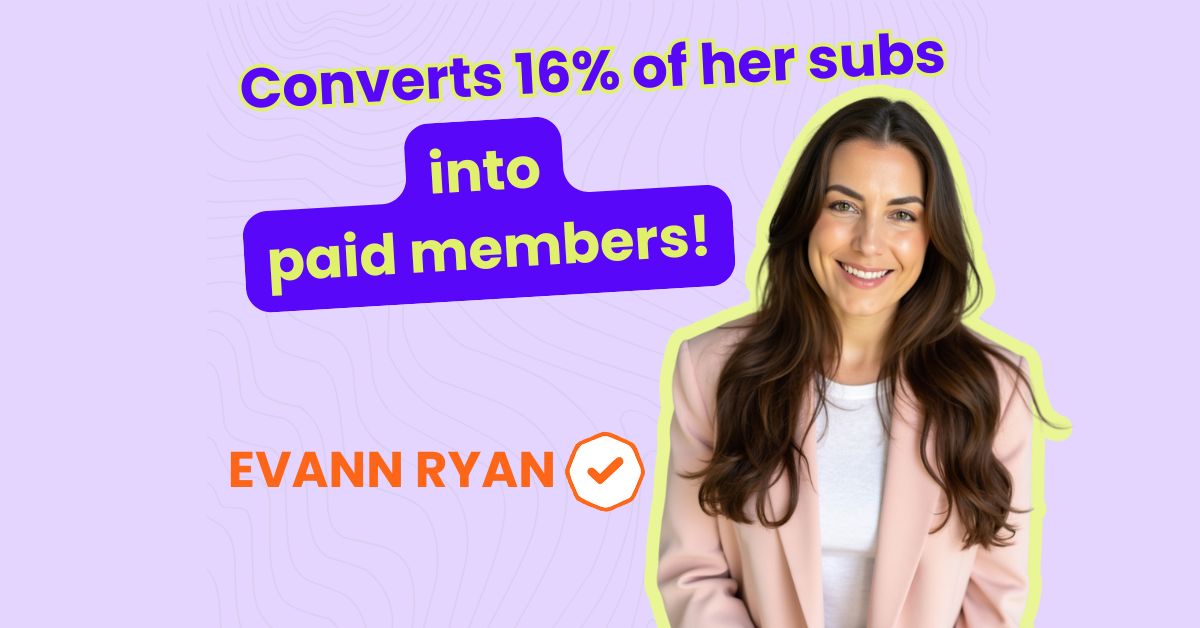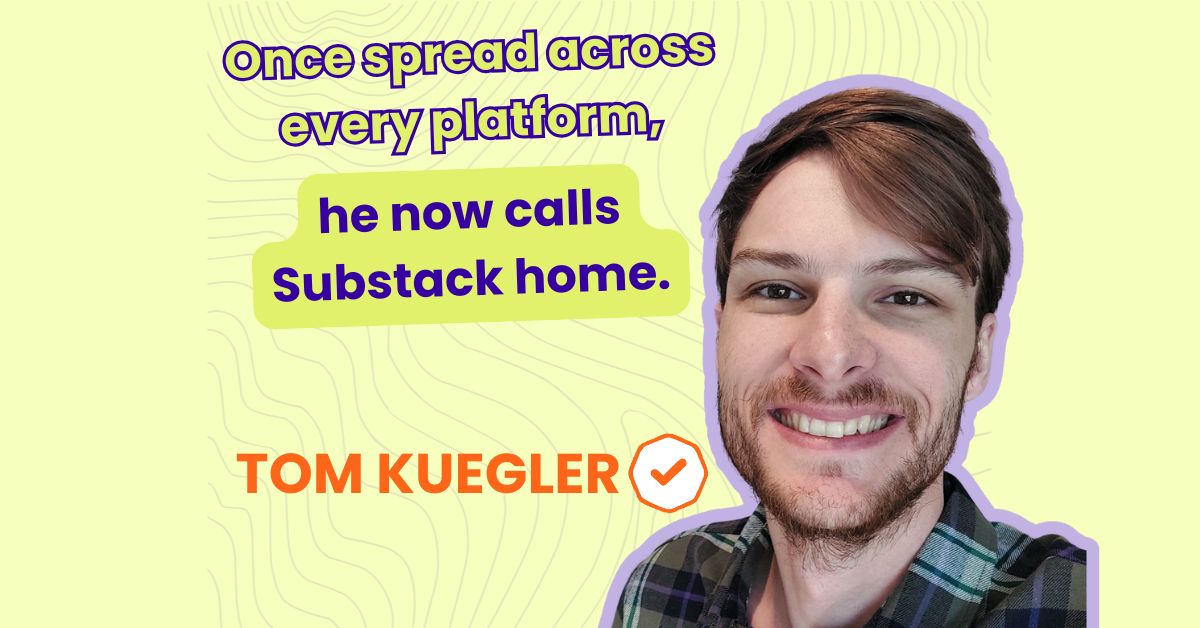Interview Date: July 13, 2025
Table of Content
- Meet Matt Trinetti & Lindsey Trout Hughes
- Newsletter Identity Card
- Their tool stack to run their newsletter
- Why they started a newsletter as an extension to their business
- How they grew 20,000+ subcribers and got 6,000 subscribers with one Notes
- Strategies they used to reach 180+ paid members
- Personal & professional impact of running a newsletter
MEET THE CREATOR
Matt Trinetti and Lindsey Trout Hughes, are the co-editors of Writers’ Hour Magazine newsletter and core team members of the London Writers’ Salon, a writing community where writers write, learn, and build creative lives together.
After years of helping thousands of writers show up daily to write, they decided to take their creative prompts to the launch of Writers’ Hour Magazine on Substack, and turned a simple writing ritual into a global community.
But, this isn’t your average newsletter.
Instead of publishing their own writing, they publish yours.
Each week, they offer a fresh prompt, a tight 500-word limit, and a prize for the best submission, making writing feel like play again.
Since launching in September 2024, they’ve grown past 20,000 subscribers, built a thriving community, and proven that generosity, collaboration, and consistency can create a publishing model that truly serves writers.
Here are the biggest takeaways from our interview:
- Stand out by serving differently: Writers’ Hour Magazine breaks all the typical Substack “rules”—they don’t publish essays, don’t write personal stories, and don’t ask for money. Instead, they give away prizes, commission original artwork, and highlight other writers.
- Creativity with constraints works: Weekly prompts with a 500-word limit and tight deadlines motivate writers. The simplicity and urgency are key to maintaining engagement.
- Substack Notes played a massive role in growth: They leaned into Notes around the 5,000-subscriber mark, with one Notes going viral and bringing in over 6,000 new subscribers.
- They treat paid subscriptions as patronage, not a paywall: Writers who upgrade to paid are helping fund the project—prize money, artist commissions, and editorial work—rather than just paying for extra content.
- Community-led experimentation fuels everything: From feedback lotteries to live events and future perks like craft essays or extended deadlines, every idea comes from listening to what their audience wants and needs.
NEWSLETTER IDENTITY CARD
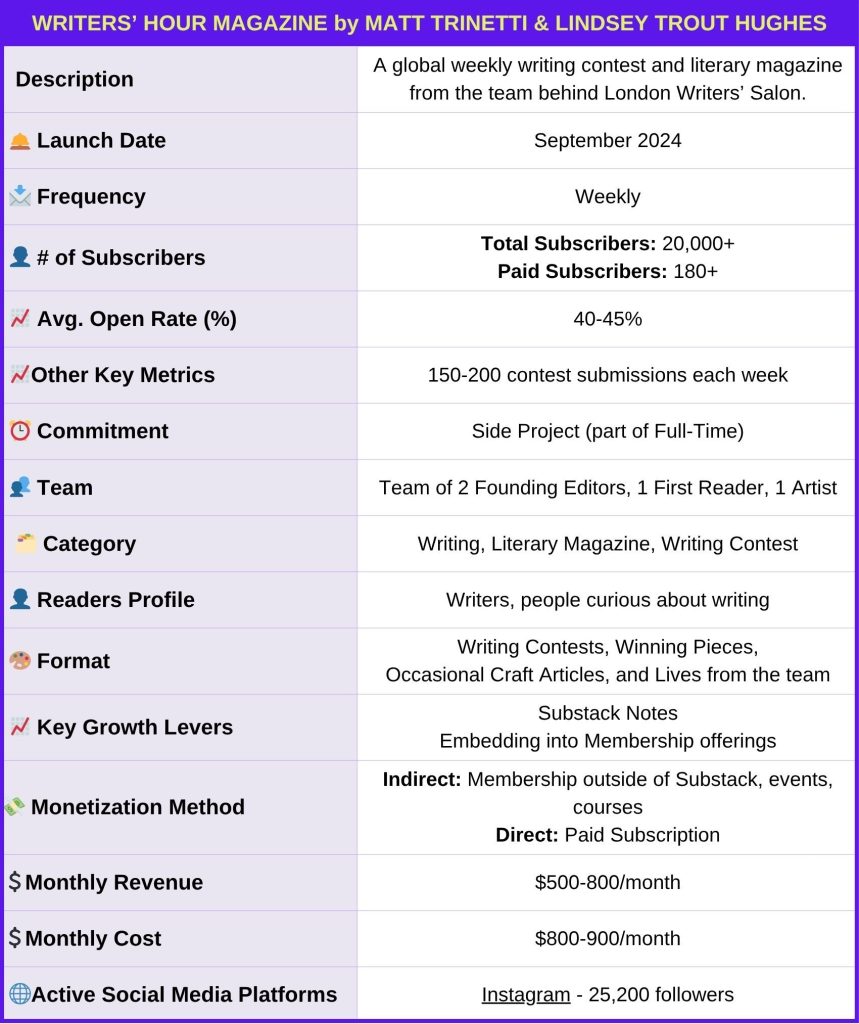
TOOL STACK
- ESP: Substack, Mailchimp
- Writing: Google Docs
- Task Management: Google Sheets
- Visual design: Canva
- Webinars: Zoom, Luma, Substack
- Digital Products: Submittable (to process submissions), Circle (Community Portal), Ousteta (Membership management)
- Social Media Tools: CapCut
- Payments: Stripe
START
Writers’ Hour Magazine is an extension of your main work at London Writers’ Salon. What motivated you to start this newsletter, and how do you position it within your overall business and community strategy?
Writers’ Hour Magazine is very much an extension of our work at London Writers’ Salon. Since March 2020, we’ve hosted daily Writers’ Hour sessions – silent writing gatherings on Zoom – along with interviews, workshops, meetups, and a podcast that now serve thousands of writers around the world.
Over time we noticed a recurring theme, especially from newer or creatively blocked writers: “I don’t know what to write. I just need a nudge / a deadline / something to get me going.” So in 2022, we began sharing weekly creative writing prompts inside our member portal.
In September 2024, we decided to turn those prompts outward. Substack felt like the right home as more of our members were launching publications there, and it’s where the broader writing community was gathering. So we launched Writers’ Hour Magazine.
Our aim was to repurpose those internal prompts as a playful, public-facing experience, offering writers a low-stakes but high-momentum contest: a fresh prompt each week, an approachable 500-word limit, a tight deadline, and the chance at prizes and publication.
Strategically, it aligns with our broader mission: to nourish the creative lives of writers, and to build spaces where to help them show up, connect, and deepen their practice. But it also feels values-aligned: generous, collaborative, and treating writing like a workout.
We’ve positioned Writers’ Hour Magazine as an independent offering from our core membership, while still clearly pointing readers toward our member community for deeper support.
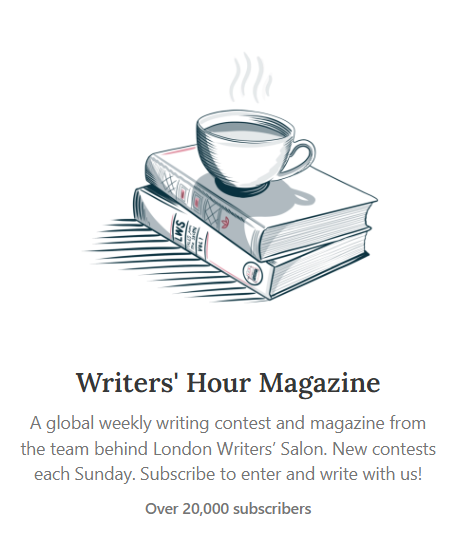
Your newsletter stands out by organizing contests and featuring subscribers’ winning pieces instead of following a typical format. What inspired this idea, and why did you choose Substack as the platform to bring it to life?
We knew if we were to achieve any sort of success on Substack – while staying aligned with our values and without burning out our tiny team – we had to be countercultural to stand out.
We decided:
1. Instead of writing essays and articles — we’d write a creative writing prompt for other writers.
2. Instead of publishing our own writing — we’d publish other people’s.
3. Instead of asking for money — we’d give it away.
4. Instead of using stock or AI-generated images — we’d commission a real human artist to make bespoke artwork.
Since we already had a sustainable business model with our membership and Writers’ Hours, we were able to treat our publication on Substack as an experiment to reach more writers, on a growing platform, in a unique way.
We had a hunch that offering writers a chance at publication, with a cash prize, and an accessible creative prompt with a deadline would be a fun and generous offering. Something writers would gravitate to and tell other writers about.
We chose Substack because the writing community was already gathering here. Plus, we saw how Substack was building discoverability into the experience, and we had a hunch building here would give us the best shot of reaching more writers.
GROWTH
Which strategies did you use to grow over 20,000 subscribers?
In a way, our strategy has been the same from day 1, from 0 to 20,000 subscribers.
1. Show up consistently. We’d publish every week, without fail (except for a scheduled break over the holidays.)
2. Show up simply. We’d publish a 1-2 sentence creative writing prompt, and invite writers to submit new writing inspired by it. Our submission requirements would be approachable and urgent: 500 words max, any genre, with a 1-week deadline.
3. Show up professionally. While we were a startup publication, we wanted to be indistinguishable from a long-established one and show up with excellence. That included beautiful bespoke artwork by Emma Winterschladen and the impeccable editorial taste (and work ethic) of Lindsey and Kira.
4. Show up collaboratively. Each week we’d invite a writer we admired – typically with a presence on Substack – to be our guest judge and craft a prompt inspired by their writing, showcasing their great work in a unique way.
We also aimed to make it an easy ‘yes’ for guest judges: We do the lion’s share of the reading, and send judges the top 5-10 entries (each max 500 words) for them to select the top 3.
5. Show up to serve. We aim to serve writers in ways they’re not being served elsewhere. And we love doing it. For the publication, that meant giving writers a creative writing prompt to help support their process — while offering a chance for them to see their words in print and win a cash prize — with a $0 submission fee.
That said, here are some things we did at each of these milestones:
0 – 1,000 Subscribers
- Invited our members and Writers’ Hour attendees to subscribe (But did not automatically subscribe them – we wanted to treat this as a standalone offering and see if we could grow from scratch.)
- Pointed to our Substack in our other newsletters.
- Gave our paying members free access to the Paid tier.
- You have to be subscribed to our publication to enter the contest and receive the prompt each week.
1,000 – 5,000 Subscribers
- Experimented with Instagram ads
- Kept showing up consistently, week after week.
5,000 – 10,000+ Subscribers
- Leant heavily into Notes. Lots of experimentation here, posting consistently.
- Some Notes went viral (got 6k+ subs from a single Note!)
Note: Growth in June was largely due to that note, alongside others. No main change in strategy, other than leaning more seriously into Notes and continuing to publish and show up weekly.
Regarding growth efforts, what would you do differently if you had a chance to start over?
Started sooner!
MONETIZATION
How many paid subscribers do you have? How long did it take for you to become a Bestseller?
We have 180 paying subscribers. Some of these are our paying LWS Members who get complimentary ‘paid’ membership.
When did you launch your paid subscription and how did you decide that it was the right time for you to activate it?
We turned on paid after 4 months. However, until recently, we were not actively encouraging paid. We treated it more as a ‘tip jar’ for writers who wanted to support the publication.
From day one our main goal has been to build trust with writers. And through trust, hopefully build traction. And once we had traction, we could explore what an exciting paid tier would be.
What are your strategies to convert free subscribers into paid ones or gain new paid subscribers?
We’ve just started to lean into a strategy for paid subscribers.
We held a Live recently and asked writers what they would find exciting at paid level. The biggest request: feedback on their submissions.
So a few weeks ago, we introduced a weekly feedback lottery. Three paid subscribers each week are chosen at random to receive personalized feedback from our editorial team on their contest submission.
We also offer discounts on some of our deeper offerings, like our Summer of Creative Joy course kicking off on June 30.
We have more ideas to continue making the paid tier exciting. Things like:
- Publishing craft essays
- Early access to prompts
- Extended deadlines to enter weekly contest
- Behind-the-scenes craft commentary – insights into why each piece got selected to serve as learning moments
- Monthly “prompt socials” where we write together and share our works-in-progress, similar to our Writers’ Hour sessions.
- Increasing the prize money as paid subscribers increase
(We haven’t committed to any of these yet! Just ideas.)
Ultimately, we see paid subscriptions as a way for readers to help sustain a publication they love, not just for the perks, but to help fund prize money, artist commissions, and the work that goes into making this feel special every week. And even better if we can help writers improve and deepen their craft.
You focus on building a private community for your paid subscribers rather than paywalled content. What was your process for launching a paid community, and how did you determine what your audience expected from it? In your experience, what are the most important criteria for running a successful paid community?
We launched our paid community back in March 2020—five years before our Substack—through our daily Writers’ Hour sessions. What started as a two-week pandemic experiment quickly became something people relied on.
Writers told us it was helping them stay grounded, creative, and connected. Within a couple days of starting Writers’ Hour, people wanted a way to support it financially. So we built a membership around what people were hungry for: spaces to connect, accountability structures, interviews, workshops, craft sessions, coaching, etc.
Our approach has always been simple: listen to what writers need, then build it for them. Quickly, generously, and iteratively.
Some thoughts on what we’ve learned about making a paid community thrive:
- Be in the room with the people you aim to serve:
- Listen to what they need or want.
- Build those things for them, quickly and generously, with love and care. Like you’re giving little gifts.
- Keep refining. Involve your members in shaping what comes next.
- Fall in love with being of service.
- Make it easy for people to pay to support and be a part of what you’re building:
- Make the value proposition as clear and simple as possible (we’re still working on this).
- Also freely give things away.
- Be quick to offer discounts, refunds, free access to certain things for people who need it most.
- Always have valuable freebies on hand.
- Find the true audience:
- Keep an eye out for exceptional people, the stars who share your vision, with enthusiasm, and are quick to offer ideas and help you build. Put them in positions to shine. Make contribution easy.
- You won’t be for everyone, and that’s okay. You’ll get better at noticing who that might be. Gladly show them the door. Even better if you can suggest a place that might be a better fit.
- Keep experimenting. Keep having fun:
- Make sure you follow your own excitement, and find a way to align that with what you’re building.
- Build processes and systems to free you up to continue to do the most important work: Delighting people, making things better, stepping into your never-ending next frontier as a leader.
- Also: it never ends. Learn how to enjoy the process of building, growing, evolving.
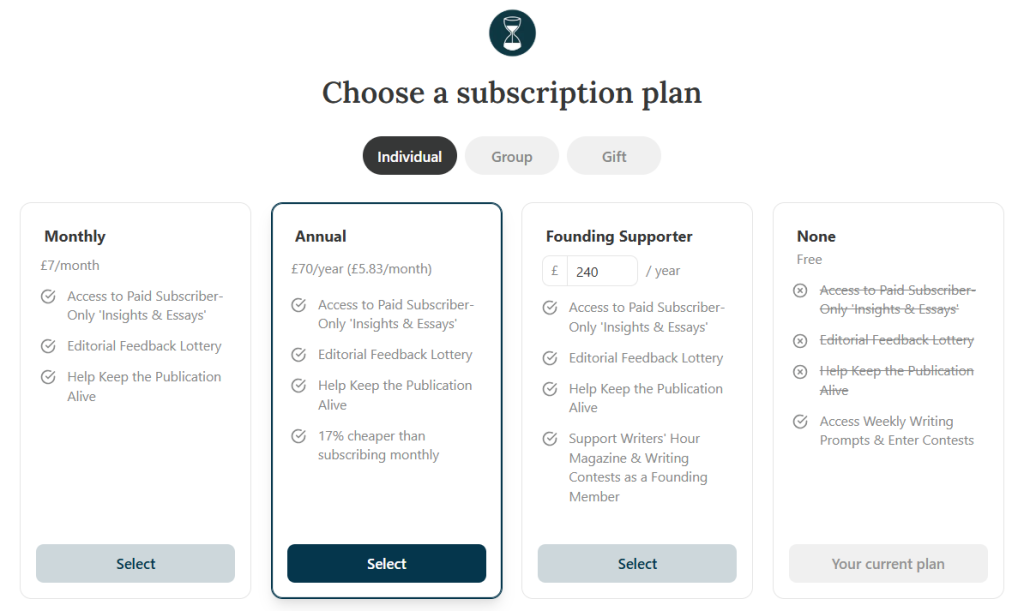
IMPACT & LEARNINGS
How did building Writers’ Hour Magazine newsletter contribute to your life professionally and personally?
We’re having so much fun. It’s a chance to build something that doesn’t yet exist, and serve people we love serving.
What would you do differently if you had a chance to start over Writers’ Hour Magazine?
Brought more first readers in to help with reading submissions each week.
What would it be if you had the right to give one piece of advice to aspiring newsletter creators?
Treat your newsletter as a gift. In the words of Steven Pressfield:
“Creative work is not a selfish act or a bid for attention on the part of the actor. It’s a gift to the world and every being in it. Don’t cheat us of your contribution. Give us what you’ve got.”
Even if you’re writing for self-expression or exploring something personally, if you’re publishing with a goal to grow a readership, you have to put yourselves in your readers’ shoes.
Personal rule of thumb: I write for me, but I edit for you.
Where to find Matt Trinetti and Lindsey Trout Hughes
- “Writers’ Hour Magazine” Newsletter

